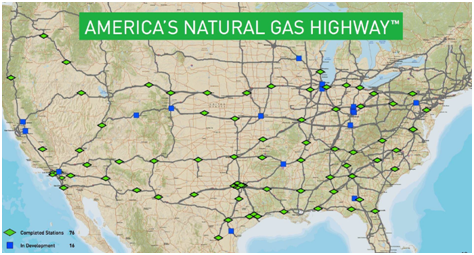The list of major companies transitioning part of their trucking fleets to natural gas is astounding. Lowes, FedEx, Monarch Beverage and P&G are all jumping on board…just to name a few companies.
The shift to natural gas is creating subtle changes across America’s highways. The number of natural gas fueling stations is on the rise. This is allowing tucking fleets to convert over to this clean burning and abundant fuel for more than just regional routes. Soon, natural gas-powered trucks will be able to travel across the country.
Over the next decade the build out of natural gas infrastructure is likely to be a topic of everyday discussion. Businesses will convert first. But soon consumers will be weighing in on the benefits of natural gas vehicles, just as we do now on diesel, gas and hybrid-electric options.
This is all possible because there is so much cheap natural gas in the U.S. We just need more fueling stations. This has been the biggest constraint to growth in the natural gas vehicle market; only about 1,200 stations in the U.S. currently sell natural gas. That’s less than 1% of all gas stations
But more stations are on the way. China’s privately held ENN group plans to build 50 natural gas filling stations across the U.S. in 2013 alone. And Royal Dutch Shell has teamed up with TravelCenters of America (NYSE: TA) to provide natural gas pumps at more than 100 truck stops.
Perhaps the most well known company driving the build-out is Clean Energy Fuels (NASDAQ: CLNE), a long-time provider of natural gas to fuel stations. Clean Energy counts T. Boon Pickens as a large shareholder and director, and has over 300 fueling stations nationwide.
It has a vision of building “America’s Natural Gas Highway.” The project consists of a compressed natural gas (CNG) and liquefied natural gas (LNG) fuel-station network connecting 48 states.
The map below shows Clean Energy’s vision. The green diamonds show the company’s 76 completed stations and the blue squares show the 16 stations currently under development.

Clean Energy’s goal is that both long-haul and regional trucks will be able to access fueling stations so they can travel the nation’s highways running on this clean fuel.
The market opportunity is significant for heavy duty trucks hauling shipping containers. It’s estimated that these trucks consume 25 billion gallons of fuel every year, more than 10 times the amount used by refuse trucks. That’s why FedEx and Lowes, among others, are converting.
Refuse trucks have proven that natural gas can replace diesel. According to Clean Energy’s figures, 60% of refuse trucks sold in 2013 run compressed natural gas engines (CNG). Many buses have made the shift too – around 30% of transit buses use natural gas.
Adoption in heavy duty trucks has been much lower however, less than 1%. But that’s likely to change as new engines become available in 2014 for bigger trucks. These trucks use LNG which is more suited to long trips than CNG because of its much higher energy density. This means a truck with LNG tanks can run as far as a truck with diesel fuel tanks.
Is the technology expensive? Yes, you bet.
A typical LNG outfitted truck might run $40,000 to $80,000 more than a similarly powered diesel truck. But given the cost savings of natural gas, energy-consultant firm IHS figures the break-even point comes just three years into the investment.
After that, it’s all cost savings. And given the relatively long life of many heavy duty trucks, this is a compelling value proposition.
 Facebook
Facebook
 Twitter
Twitter